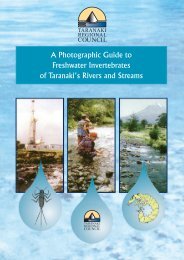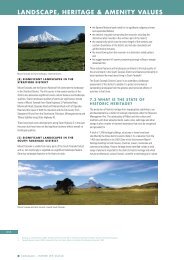Annual report 2006-2007 - Taranaki Regional Council
Annual report 2006-2007 - Taranaki Regional Council
Annual report 2006-2007 - Taranaki Regional Council
Create successful ePaper yourself
Turn your PDF publications into a flip-book with our unique Google optimized e-Paper software.
24 March 2005, under Section 87(e) of the Resource Management Act. It is due to<br />
expire on 1 June 2022.<br />
Special conditions 1, 2, 3 and 4 relate to adopting the best practicable option and<br />
exercising the consent in accordance with the application, and notification<br />
requirements.<br />
Special condition 5 defines the information to be included in a Waste Burial<br />
Management Plan, and that the disposal shall be in accordance with this plan.<br />
14<br />
Special conditions 6 and 7 define the type of product and circumstances (emergency)<br />
in which this consent should be used.<br />
Special conditions 8 and 9 define boundaries beyond which no adverse effects shall<br />
occur and special conditions 10, 11, 12, 13, and 14 define the requirements to keep<br />
records of disposal, and burial cover and rehabilitation requirements.<br />
The last two conditions are consent lapsing and review requirements.<br />
The permits are attached to this <strong>report</strong> in Appendix I.<br />
2.3 Monitoring programme<br />
The monitoring programme for <strong>Taranaki</strong> Abattoirs consisted of three primary<br />
components in addition to the programme liaison and management.<br />
2.3.1 Site inspections<br />
The abattoir and rendering site was visited five times during the monitoring period<br />
for routine site inspections. With regard to consents for the abstraction of or<br />
discharge to water, the main points of interest were plant processes with potential or<br />
actual discharges to receiving watercourses, including contaminated stormwater and<br />
process wastewaters. Air inspections focused on plant processes with associated<br />
actual and potential emission sources and characteristics, including potential odour,<br />
dust, noxious or offensive emissions. Sources of data being collected by the consent<br />
holder were identified and accessed, so that performance in respect of operation,<br />
internal monitoring, and supervision could be reviewed by the <strong>Council</strong>. The<br />
neighbourhood was surveyed for environmental effects.<br />
2.3.2 Chemical sampling<br />
The <strong>Taranaki</strong> <strong>Regional</strong> <strong>Council</strong> undertook sampling of both the discharges from the<br />
site (site 2, Figure 1) and the water quality upstream and downstream of the<br />
discharge point and mixing zone (sites 1 and 3, Figure 1).<br />
The aerobic pond discharge (site 2) was sampled on five occasions, and the sample<br />
analysed for conductivity, dissolved oxygen, ammonia and chemical oxygen<br />
demand. On one of these occasions (and in conjunction with the low flow survey of<br />
the receiving water), pH, suspended solids, biochemical oxygen demand, total<br />
nitrogen and total phosphorus were also analysed.














